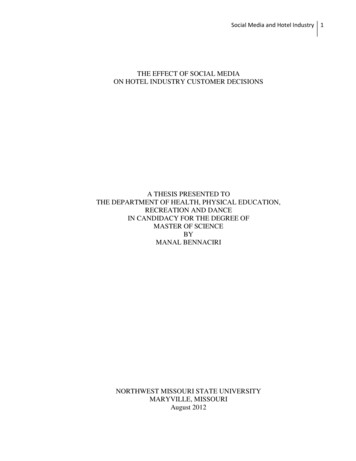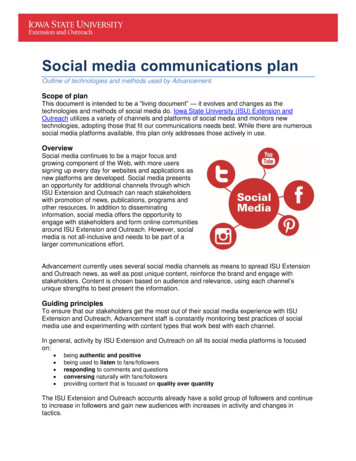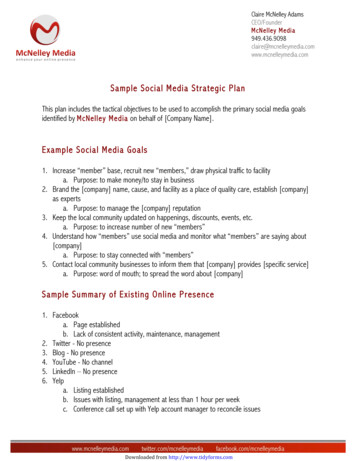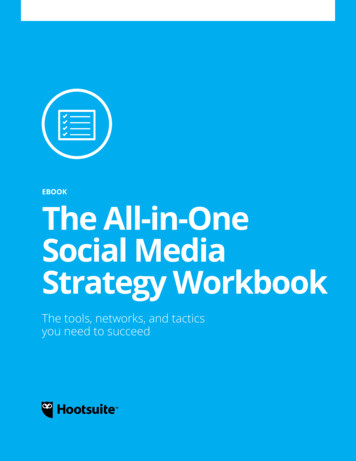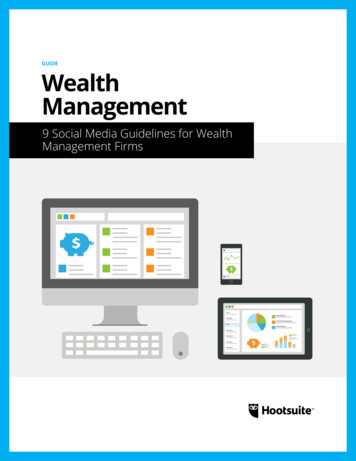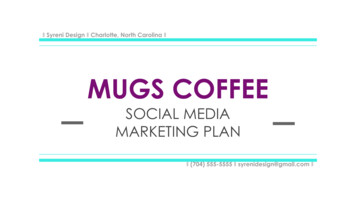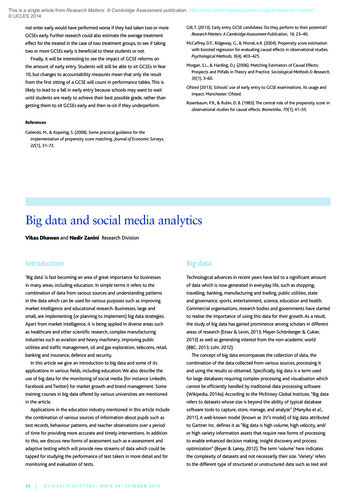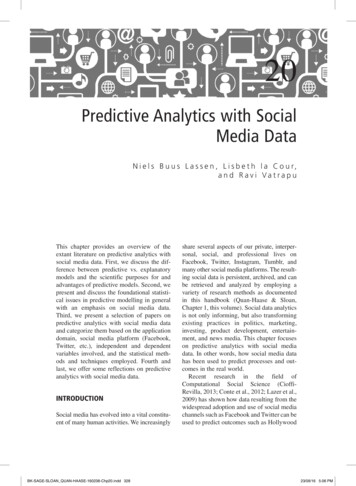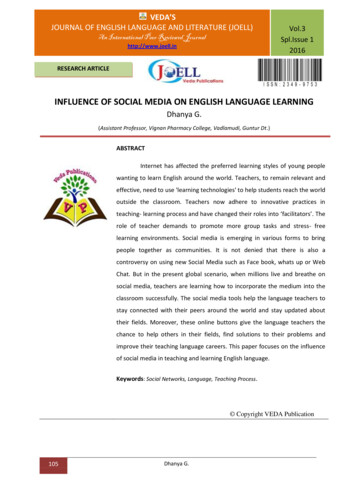
Transcription
Introduction to Social Media
Today’s Discussion Overview of Web 2.0 andsocial media tools How EPA and other agenciesare using these tools Agency and governmentwide policies governing use oftools Case studies
Web 2.0 Second generation of the World Wide Web,especially the movement away from static web pagesto dynamic and shareable content and socialnetworking. Web applications that facilitate interactiveinformation sharing, interoperability, user-centereddesign, and collaboration on the World Wide Web. For a more detailed history on the evolution of theweb http://www.youtube.com/watch?v 6gmP4nk0EOE
Web 2.0 Content, Conversation, Communication User-Generated Content Users Want to: Create and Co-Create Content Edit Content Rate Content Comment on Content Discuss Content Tag and Organize Content Mash Content with other Content Personalize Content Share Content
Why should you care? There are over 100 million worldwide views per dayon YouTube There are more Facebook users (350 million) thanthere are U.S. residents (309 million) Twitter will process about 10 billion "tweets" thisyear Fastest-growing Facebook segment: ages 35-54 “Force multiplier” through sharing The way business is being done
Why should you care?Nearly 3 in 4 people participate in at least one onlinecommunity or social network.Facebook (58%)Myspace (24%)Groups (12%)Forums (9%)Flicker (6%)FourSquare (2%)Source: Red CrossYoutube (31%)Twitter (15%)LinkedIn (9%)Blog (7%)Yelp (2%)
Why should you care?The majority (82 percent) participates in socialmedia at least once a week, with nearly halfparticipating every day or nearly every day. Every day or almost every day (48%) A few times a week (25%) Once a week (9%) A few times a month (10%) Less than once a month (8%)Source: Red Cross
Why should you care?One in six (16%) have used social media to getinformation about an emergency TV news (63%) Local radio (44%) Online news (37%) Facebook (14%) Local gov website (12%) Disaster agency website (10%) Mobile apps (7%) Twitter (6%) Text alerts from local government (6%) Flickr (2%)Source: Red Cross
Why should you care?During an emergency, nearly half woulduse social media to let loved ones knowthey are safe. Definitely would (28%) Probably would (21%) Might or might not (22%) Probably would not (13%) Definitely would not (16%)Source: Red Cross
Some words of advice These are tools, not answers—and there is nosilver bullet. Crawl, walk, run! Consult with people who’ve done it first. Get permission. Don’t expect to change the world.
Why are governments using socialmedia? It’s where people are Expand reach to new and diverseaudiences and have those audiences REACH US Facilitate interactive communication &community Put human face on government Reduce duplication Save time and money Leverage unique characteristics of emergingchannels
What are the tools we’re using? Social Networking Sites (i.e. Facebook) Micro-blogging (i.e. Twitter) Video Sharing (i.e. Youtube) Photo Sharing (i.e. Flickr) Blogs Podcasts and Vodcasts Wikis Social Bookmarking Sites Widgets Virtual Worlds Social Media Releases RSS Feeds
What does EPA use? Facebook, YouTube, Twitter, Flickr, Dipity, and more Learn more about EPA’s social media activities athttp://www.epa.gov/epahome/socialmedia.html
Social Networking Connecting people globally -- most includepersonal profiles, find friends, andcommunities Facebook and Myspace are the most widelyused in the U.S. LinkedIn popular for professional networking
Social Networking www.facebook.com Started in 2003 by Harvardstudent A platform to shareannouncements, requestsfor feedback, questions,and links with aninterested community thatalso gives people a place toshare information witheach other Person-based, groups, orpage-based accounts Average user spendsalmost 1 hour per day onFacebook
EPA Example Use of Facebook National page Administrator Lisa P. Jackson EPA Clean Air Markets EPA Design for the Environment EPA Federal Advisory Committees EPA Water Is Worth It Gowanus Canal, NY group Indoor airPLUS Pick 5 for the Environment Pompton Lakes, NJ group Region 2: NY, NJ, Puerto Rico, VirginIslands Region 6: AR, LA, NM, OK, TX Region 9: CA, AZ, NV, HI, Pacific Region 10: AK, ID, OR, WA and 271 tribes Spanish US-Mexico Border Waste Forum WaterSense More than40,000people!(All of whomhave taken thetime to indicatethey want tohear what wehave to say.)
For more help http://www.facebook.com/help 10 Part Video Series– -For-A-Facebook-Profile YouTube videos– http://www.youtube.com/watch?v QCVi050Vmo&feature related
Micro-blogging A form of blogging thatallows users to post very brief,simple text updates (textmessage size) Twitter! Reach new audiences Real time reporting Emergencies
Micro-blogging Potential Uses Emergency updates (fires, earthquakes,floods.) News updates/breaking news alerts Security situations Weather information General website updates Local government – fires, crime watches,fugitive alerts, utilities interruptions, traffic,road construction Reminders (file your taxes, Medicareapplication deadlines, other governmentbenefit deadlines) Event invitations
What is Twitter? www.twitter.com Short text updates, 140characters Updates often deliveredto mobile devices forimmediate notification Estimated1 billion usersby 2013 A searchable database ofwhat’s happening now
EPA’s use of Twitter Used to spread the word on agency responses toemergencies, announce rule makings, publicationreleases etc. Several offices at EPA tweet as well as programs toengage the public and keep them informed of timelynews releases, due dates, etc.
Morethan100,000people!
Brainstorm What part of your job could beTweeted regularly? Who would listen to your tweets? What are the risks? What are the benefits? Practice exercise
For more help YouTube videos– http://www.youtube.com/watch?v ddO9idmax0o Twitter Applications– / Twitter help– http://help.twitter.com/forums
YouTube www.youtube.com Founded in February2005 Google purchased in2006 for 1.6B World's most popularonline videocommunity, People watch andshare originallycreated videos. Youtube is the #2Search Engine in theworld
Why is the Government SharingVideo? Multimedia makes compelling content New audiences Public outreach Education and training How To videos & audios to improveservice & achieve mission Cost savings
EPA’s Use of YoutubePrimarily usedas outreachduringemergencies,public contests,and archiving ofvideos
What could you do with Youtube? What are your communication needs? What content is readily available or best shownthrough video? What does EPA do versus what are communitygroups encouraged to do? Illustrate clean up technologies to communities? Show state of site conditions, video tours of sites? Record trainings or town hall meetings?
For more help with Youtube http://www.youtube.com/youtube ide-To-YouTube
Photo-sharing and Flickr Online photo and videomanagement andsharing application Founded in 2004,acquired by Yahoo in2005 4 billion imagesuploaded
EPA’s Use of FlickrEPA has a photostream updated athttp://www.flickr.com/photos/usepagov/Primarily used as outreachduring emergencies, publiccontests, and archiving of photosTo add to the EPAphotostream you mustcontact your local webcoordinator
What could you do with Flickr? What work do you do involvingdigital images? Share photos of site conditions,field work, clean up progress etcwith the public– Allow the public to share photos historic photos of area
For more information http://www.flickr.com/help/ http://www.youtube.com/watch?v 3R MWGFvDEE ml http://www.passyworld.com/passyPDFs/Flickrbpw.pdf
Blogs Web log Online journal or diary with social collaborationWhy the Government Blogs Reach new audiences for government informationand service Put a human face on government Start a conversation (likely more informal) Surface issues and solve them
Podcasting Multimedia content (audio, video) syndicatedover the Internet via a Web feed For use on portable media players (iPod, Mp3players) and personal computers Not just an audio or video file, podcasts aresyndicated or subscribed to Downloaded automatically when new content isadded using an aggregator or reader
Mashups Combine content from multiplesources for an integratedexperience Early examples use mapping:Microsoft Virtual Earth, GoogleEarth, Google maps
General process to use any socialmedia or network Many offer public anonymous searching, browsing and access tofiles (e.g. Youtube, Flickr, ----------------------------------------------- Visit site and create account– Account must be verified, usually by clicking on a confirmation link in email Update your profile/representation in the site/community– Think about professional vs personal and individual vs organization Contribute information to the community– Usually through website posting and uploads– Many newer mobile options Build networks by associating or establishing connections with otherusers– Usually a 2-part process where a request to connect is made and therequest is accepted or rejected
Questions to think about What is your plan for using social media?– How long will it be active?– Will it be used for one site/activity or will you use a general account for allactivities? How will you manage account(s)?– Allow only one staff member to use or share with other co-workers– Access on mobile devices for immediate alerts? How will you handle comments?– Filter all comments? Disable comments? Allow anyone to comment? How frequently will you check and/or post content?– Notifications on what content? Delivered where/how? Privacy concerns?
Nearly 3 in 4 people participate in at least one online community or social network. Facebook (58%) Youtube (31%) . Short text updates, 140 . _bpw.pdf We

